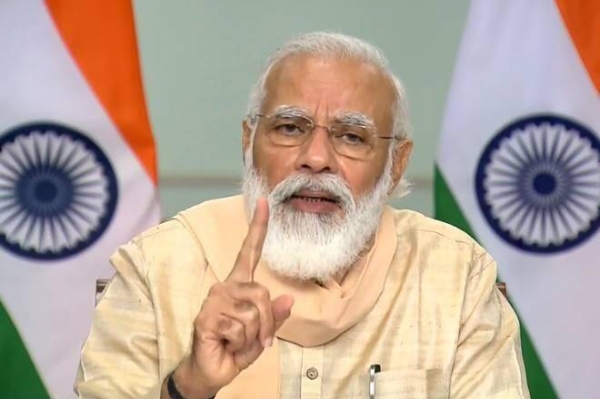Why widespread virus damage failed to dent the image of India's most popular political leader
Weak Opposition In the absence of significant national opposition, voters have long been willing to place restrictions on Modi, according to Milan Vaishnav, di
- by B2B Desk 2020-10-21 09:05:16
India is battling one of the world's highest coronavirus caseloads, its worst economic recession, shuttered factories, farmer protests and the deadliest border fighting with China in decades.
However, Prime Minister Narendra Modi seems to maintain his popularity as always. Opinion polls in Bihar, where he faces his first major electoral test since the pandemic, from October 28 to November 7, show that his coalition comfortably maintains control of the state government. A separate India Today survey “Mood of the Nation” poll in August said that 78% rated his performance "good to outstanding" compared to 71% last year.
One such supporter is Sanjay Kumar, 22, a carpenter who was beaten by police in April for violating India's strict ban while cycling from New Delhi to his village in Bihar, a journey of more than 1,000 kilometers, after losing his job. He’s still unable to find regular work.
"Some people don't getting the full benefits due to corruption in the middle and that is not his fault,” Kumar said, , noting that Modi cannot control the spread of the virus if people don't wear masks. "No one can question their good intentions," he said. "He is doing everything he can to provide food and work for the poor."
Many other Modi backers also blame others for India's problems, and there is no shortage of targets: central government bureaucrats, state governments, village leaders, opposition parties, and even their own citizens. The prime minister has helped make himself a darling of India's poor by meeting their daily needs with programs to supply gas for cooking, toilets and housing, all in keeping with the right-wing playbook.

Weak Opposition
In the absence of significant national opposition, voters have long been willing to place restrictions on Modi, according to Milan Vaishnav, director and senior fellow of the South Asia Program at the Carnegie Endowment for International Peace.
"This kind of policy, however, is not without its flaws," Vaishnav said. “Mr. Modi was able to make this argument effective in 2019, but it will be much more difficult in 2024 if he cannot achieve faster progress in the economy, employment, and governance.
As Prime Minister, Modi has focused on making India attractive to global investors and the cheeky majority. His BJP returned to power in May of last year with an overwhelming majority after a campaign that highlighted his success in providing necessities to the poor, along with a majority nationalist agenda that reinforced his strong character, especially against his arch-enemy Pakistan.
Since winning his re-election, Modi revoked article 370 of the constitution that granted special autonomy status to the only Muslim-majority Indian state, Jammu and Kashmir, and passed a citizenship law that discriminates on the basis of religion. He also pushed for the registration of national citizens in Assam and the laying of the foundation stone for the construction of the Ram Temple at the controversial Ayodhya site.
A spokesman for Modi's office did not respond to several requests seeking comment.
"He is popular because it has ideological clarity and it is only implementing what the BJP promised in its statement, such as the promise to repeal Article 370," said Arun Anand, research director at the Delhi-based think tank Vichar Vinimay Kendra and author of two books on the BJP’s parent organization, the Rashtriya Swayamsevak Sangh. “Politicians keeping their word is rare in India.”
Modi has positioned himself alongside other populist leaders around the world who are fueling concerns that minority groups will one day replace the majority despite the fact that Hindus make up 80% of India's population, according to Soodha Bai, political scientist, author, and resident of New Delhi. Former Vice President of the Center for Political Studies at Jawaharlal Nehru University. He added that he was also adept at leaving the details of policies to ministers and bureaucrats, who would take the blame if something went wrong.
"Now we have a populist regime that has created a leader who cannot be wrong," Pai said. "He has this way of speaking like a godman.”
Controlling the Narrative
Modi has shown that he can turn confusion into political gains. In 2016, its decision to abruptly withdraw 86% of the currency in circulation with a four-hour notice resulted in a prolonged shortage of cash and an economic slowdown that caused suffering across India. However, his party won important status by an overwhelming majority just months later, as his party told voters that it helped curb corruption and tax evasion, although it ultimately failed to achieve its goal.
Part of his success was the ability to control the narrative. Modi did not hold a single press conference as prime minister during his six years in power, but rather reached out to the public directly through a weekly radio show, as well as posts on Facebook, Twitter, and YouTube. His party's social media army has blamed the problems, even on opposition parties.
"Modi's ability to get his message across directly to individuals is unsurpassable," said Neelanjan Sircar, an assistant professor at Ashoka University and a senior visiting fellow at the Center for Policy Research. "I am increasingly convinced of the relationship between creating a leader with a strong charismatic personality and a media-dominated narrative. How do you build trust in someone? You keep telling the stories that build their credibility."
As the Covid-19 outbreak in India has become one of the fastest-growing in the world, Modi shared a carefully crafted video in August showing him feeding peacocks at his official residence during his morning exercise regime. Nilanjan Mukhopadhyay, a political analyst who wrote an autobiography on Modi, said this kind of imagery has helped cement an image of Modi as “a monk-like ascetic who can be trusted with one’s life.
Sahebrao Patil, a 60-year-old driver in Maharashtra who has suffered a loss of income after the lockdown, is among those who say Modi can do no wrong.
He said, "I believe with all my heart that Modi cannot lie." "We are not even asking who the candidate is. We just vote for Modi.”

POPULAR POSTS
Loan EMIs to Drop as RBI Slashes Repo Rate - Full MPC December 2025 Highlights
by Shan, 2025-12-05 11:49:44
Zoho Mail vs Gmail (2025): Which Email Platform Is Best for Businesses, Startups, and Students?
by Shan, 2025-10-09 12:17:26
PM Modi Launches GST Bachat Utsav: Lower Taxes, More Savings for Every Indian Household
by Shan, 2025-09-24 12:20:59
$100K H-1B Visa Fee Explained: Trump’s New Rule, Clarifications & Impact on Indian Tech Workers
by Shan, 2025-09-22 10:11:03
India-US Trade Deal Soon? Chief US Negotiator Arrives in Delhi as Talks Set to Begin Tomorrow
by Shan, 2025-09-15 11:54:28
Modi Meets Xi: Trump’s Tariffs, Strategic Autonomy, and the Future of Asia’s Power Balance
by Shan, 2025-09-03 06:40:06
Google Claims Gemini AI Uses Just ‘Five Drops of Water’ Per Prompt, Sparks Debate
by Shan, 2025-08-22 12:34:27
RECENTLY PUBLISHED

Pine Labs IPO 2025: Listing Date, Grey Market Premium, and Expert Outlook
- by Shan, 2025-11-05 09:57:07

The Agentic Revolution: Why Salesforce Is Betting Its Future on AI Agents
- by Shan, 2025-11-05 10:29:23

Top 10 Insurance Companies in India 2026: Life, Health, and General Insurance Leaders Explained
- by Shan, 2025-10-30 10:06:42

OpenAI Offers ChatGPT Go Free in India: What’s Behind This Big AI Giveaway?
- by Shan, 2025-10-28 12:19:11

Best Silver Investment Platforms for 2025: From CFDs to Digital Vaults Explained
- by Shan, 2025-10-23 12:22:46





 Subscribe now
Subscribe now 